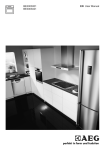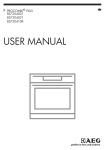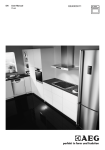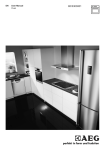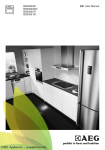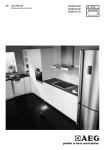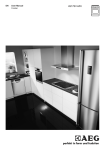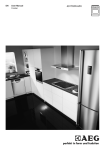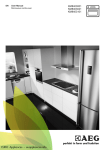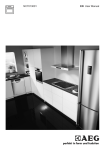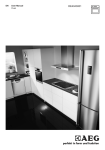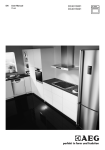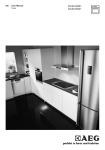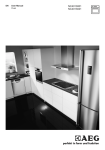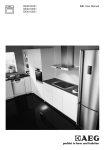Download Appliance Manual
Transcript
EN User Manual Oven BP730402K BP730410K 2 www.aeg.com CONTENTS 1. SAFETY INFORMATION.................................................................................................3 2. SAFETY INSTRUCTIONS................................................................................................ 4 3. PRODUCT DESCRIPTION.............................................................................................. 7 4. CONTROL PANEL...........................................................................................................8 5. BEFORE FIRST USE.......................................................................................................10 6. DAILY USE......................................................................................................................10 7. CLOCK FUNCTIONS.................................................................................................... 12 8. AUTOMATIC PROGRAMMES......................................................................................14 9. USING THE ACCESSORIES..........................................................................................16 10. ADDITIONAL FUNCTIONS........................................................................................18 11. HINTS AND TIPS......................................................................................................... 20 12. CARE AND CLEANING.............................................................................................. 34 13. TROUBLESHOOTING.................................................................................................37 14. ENERGY EFFICIENCY.................................................................................................39 FOR PERFECT RESULTS Thank you for choosing this AEG product. We have created it to give you impeccable performance for many years, with innovative technologies that help make life simpler features you might not find on ordinary appliances. Please spend a few minutes reading to get the very best from it. Visit our website for: Get usage advice, brochures, trouble shooter, service information: www.aeg.com Register your product for better service: www.registeraeg.com Buy Accessories, Consumables and Original spare parts for your appliance: www.aeg.com/shop CUSTOMER CARE AND SERVICE Always use original spare parts. When contacting our Authorised Service Centre, ensure that you have the following data available: Model, PNC, Serial Number. The information can be found on the rating plate. Warning / Caution-Safety information General information and tips Environmental information Subject to change without notice. ENGLISH 1. 3 SAFETY INFORMATION Before the installation and use of the appliance, carefully read the supplied instructions. The manufacturer is not responsible if an incorrect installation and use causes injuries and damages. Always keep the instructions with the appliance for future reference. 1.1 Children and vulnerable people safety • • • • • • • This appliance can be used by children aged from 8 years and above and persons with reduced physical, sensory or mental capabilities or lack of experience and knowledge if they have been given supervision or instruction concerning use of the appliance in a safe way and understand the hazards involved. Do not let children play with the appliance. Keep all packaging away from children. Keep children and pets away from the appliance when it operates or when it cools down. Accessible parts are hot. If the appliance has a child safety device, we recommend you activate it. Cleaning and user maintenance shall not be made by children without supervision. Children of less than 3 years should be kept away unless continuously supervised. 1.2 General Safety • • • Only a qualified person must install this appliance and replace the cable. Internally the appliance becomes hot when in operation. Do not touch the heating elements that are in the appliance. Always use oven gloves to remove or put in accessories or ovenware. Before maintenance cut the power supply. 4 www.aeg.com • • • • • • • • Ensure that the appliance is switched off before replacing the lamp to avoid the possibility of electric shock. Do not use a steam cleaner to clean the appliance. Do not use harsh abrasive cleaners or sharp metal scrapers to clean the glass door since they can scratch the surface, which may result in shattering of the glass. If the supply cord is damaged, it must be replaced by the manufacturer, its Authorised Service Centre or similarly qualified persons in order to avoid a hazard. Excess spillage must be removed before the pyrolytic cleaning. Remove all parts from the oven. To remove the shelf supports first pull the front of the shelf support and then the rear end away from the side walls. Install the shelf supports in the opposite sequence. The means for disconnection must be incorporated in the fixed wiring in accordance with the wiring rules. Only use the core temperature sensor recommended for this appliance. 2. SAFETY INSTRUCTIONS 2.1 Installation WARNING! Only a qualified person must install this appliance. • Remove all the packaging. • Do not install or use a damaged appliance. • Obey the installation instruction supplied with the appliance. • Always be careful when you move the appliance because it is heavy. Always wear safety gloves. • Do not pull the appliance by the handle. • Keep the minimum distance from the other appliances and units. • Make sure that the appliance is installed below and adjacent safe structures. • The sides of the appliance must stay adjacent to appliances or to units with the same height. 2.2 Electrical connection WARNING! Risk of fire and electrical shock. • All electrical connections should be made by a qualified electrician. • The appliance must be earthed. • Make sure that the electrical information on the rating plate agrees with the power supply. If not, contact an electrician. • Always use a correctly installed shockproof socket. • Do not use multi-plug adapters and extension cables. • Make sure not to cause damage to the mains plug and to the mains ENGLISH • • • • • • • • cable. Should the mains cable need to be replaced, this must be carried out by our Authorised Service Centre. Do not let mains cables touch or come near the appliance door, especially when the door is hot. The shock protection of live and insulated parts must be fastened in such a way that it cannot be removed without tools. Connect the mains plug to the mains socket only at the end of the installation. Make sure that there is access to the mains plug after the installation. If the mains socket is loose, do not connect the mains plug. Do not pull the mains cable to disconnect the appliance. Always pull the mains plug. Use only correct isolation devices: line protecting cut-outs, fuses (screw type fuses removed from the holder), earth leakage trips and contactors. The electrical installation must have an isolation device which lets you disconnect the appliance from the mains at all poles. The isolation device must have a contact opening width of minimum 3 mm. This appliance complies with the E.E.C. Directives. 2.3 Use WARNING! Risk of injury, burns and electrical shock or explosion. • Use this appliance in a household only. • Do not change the specification of this appliance. • Make sure that the ventilation openings are not blocked. • Do not let the appliance stay unattended during operation. • Deactivate the appliance after each use. • Be careful when you open the appliance door while the appliance is in operation. Hot air can release. • Do not operate the appliance with wet hands or when it has contact with water. 5 • Do not apply pressure on the open door. • Do not use the appliance as a work surface or as a storage surface. • Open the appliance door carefully. The use of ingredients with alcohol can cause a mixture of alcohol and air. • Do not let sparks or open flames to come in contact with the appliance when you open the door. • Do not put flammable products or items that are wet with flammable products in, near or on the appliance. WARNING! Risk of damage to the appliance. • To prevent damage or discoloration to the enamel: – do not put ovenware or other objects in the appliance directly on the bottom. – do not put aluminium foil directly on the bottom of the appliance. – do not put water directly into the hot appliance. – do not keep moist dishes and food in the appliance after you finish the cooking. – be careful when you remove or install the accessories. • Discoloration of the enamel has no effect on the performance of the appliance. It is not a defect in the sense of the warranty law. • Use a deep pan for moist cakes. Fruit juices cause stains that can be permanent. • This appliance is for cooking purposes only. It must not be used for other purposes, for example room heating. • Always cook with the oven door closed. • If the appliance is installed behind a furniture panel (e.g. a door) make sure the door is never closed when the appliance is in operation. Heat and moisture can build up behind a closed furniture panel and cause subsequent damage to the appliance, the housing unit or the floor. Do not close the furniture panel until the appliance has cooled down completely after use. 6 www.aeg.com 2.4 Care and cleaning WARNING! Risk of injury, fire, or damage to the appliance. • Before maintenance, deactivate the appliance and disconnect the mains plug from the mains socket. • Make sure the appliance is cold. There is the risk that the glass panels can break. • Replace immediately the door glass panels when they are damaged. Contact the Authorised Service Centre. • Be careful when you remove the door from the appliance. The door is heavy! • Clean regularly the appliance to prevent the deterioration of the surface material. • Remaining fat or food in the appliance can cause fire. • Clean the appliance with a moist soft cloth. Only use neutral detergents. Do not use abrasive products, abrasive cleaning pads, solvents or metal objects. • If you use an oven spray, obey the safety instructions on the packaging. • Do not clean the catalytic enamel (if applicable) with any kind of detergent. 2.5 Pyrolytic cleaning Risk of Injury / Fires / Chemical Emissions (Fumes) in Pyrolitic Mode. • Before carrying out a Pyrolitic selfcleaning function or the First Use please remove from the oven cavity: – any excess food residues, oil or grease spills / deposits. – any removable objects (including shelves, side rails etc., provided with the product) particularly any non-stick pots, pans, trays, utensils etc. • Read carefully all the instructions for Pyrolytic cleaning. • Keep children away from the appliance while the Pyrolytic cleaning is in operation. • • • • • The appliance becomes very hot and hot air is released from the front cooling vents. Pyrolytic cleaning is a high temperature operation that can release fumes from cooking residues and construction materials, as such consumers are strongly advised to: – provide good ventilation during and after each Pyrolytic cleaning. – provide good ventilation during and after the first use at maximum temperature operation. Unlike all humans, some birds and reptiles can be extremely sensitive to potential fumes emitted during the cleaning process of all Pyrolytic Ovens. – Remove any pets (especially birds) from the vicinity of the appliance location during and after the Pyrolytic cleaning and first use maximum temperature operation to a well ventilated area. Small pets can also be highly sensitive to the localized temperature changes in the vicinity of all Pyrolytic Ovens when the Pyrolytic self cleaning program is in operation. Non-stick surfaces on pots, pans, trays, utensils etc., can be damaged by the high temperature Pyrolytic cleaning operation of all Pyrolytic Ovens and can be also a source for low level harmful fumes. Fumes released from all Pyrolytic Ovens / Cooking Residues as described are not harmful to humans, including infants or persons with medical conditions. 2.6 Internal light • The type of light bulb or halogen lamp used for this appliance is only for household appliances. Do not use it for house lighting. WARNING! Risk of electrical shock. • Before replacing the lamp, disconnect the appliance from the power supply. • Only use lamps with the same specifications. ENGLISH 2.7 Disposal 2.8 Service WARNING! Risk of injury or suffocation. • Disconnect the appliance from the mains supply. • Cut off the mains cable and discard it. • Remove the door catch to prevent children and pets to get closed in the appliance. • To repair the appliance contact an Authorised Service Centre. • Use original spare parts only. 3. PRODUCT DESCRIPTION 3.1 General overview 1 2 3 4 5 5 4 8 3 6 2 1 1 Control panel 2 Electronic programmer 3 Socket for the core temperature sensor 4 Heating element 5 Lamp 6 Fan 7 Shelf support, removable 8 Shelf positions 7 3.2 Accessories For cakes and biscuits. Nonstick wire shelf Grill- / Roasting pan For cookware, cake tins, roasts. To bake and roast or as a pan to collect fat. Baking tray 7 8 www.aeg.com Trivet Core temperature sensor To measure how far the food is cooked. For roasting and grilling. Use the trivet only with the Grill- / Roasting pan. 4. CONTROL PANEL 4.1 Electronic programmer 1 2 3 4 5 6 7 8 9 10 Use the sensor fields to operate the appliance. Sensor Field 1 2 3 4 5 - Function Description DISPLAY Shows the current settings of the appliance. ON / OFF To activate and deactivate the appliance. OPTIONS To set an oven function or an automatic programme. MY FAVOURITE PROGRAMME To store your favourite programme. Use it to have access to your favourite programme directly or when the appliance is deactivated. TEMPERATURE / FAST HEAT UP To set and see the cavity temperature or the core temperature sensor temperature (if present). If you press and hold it for three seconds, it turns the Fast heat up function ON or OFF. Straight access to the temperature setting of the first oven function when the appliance is off. ENGLISH Sensor Field Function Description UP, DOWN To move up or down in the menu. OK To confirm a selection or setting. OVEN LIGHT To activate or deactivate the lamp. CLOCK To set the clock functions. MINUTE MINDER To set the Minute Minder. 6 7 8 9 10 4.2 Display A B G C F E D A) Oven function symbol B) Temperature / time of day display C) Clock / Residual heat display / Minute Minder D) Residual heat indicator E) Indicators for the clock functions F) Heat-up indicator / Fast Heat Up indicator G) Number of an oven function / programme Other indicators of the display: Symbol / / Name Description Functions You can choose an oven function. Automatic programme You can choose an automatic programme. My favourite programme The favourite programme operates. kg / g An automatic programme with a weight input operates. h / min A clock function operates. Temperature / Fast heat up The function operates. Temperature The current temperature is indicated. 9 10 www.aeg.com Symbol Name Description Temperature You can change the temperature. Core temperature sensor The core temperature sensor is in the core temperature sensor socket. Door lock The door lock function operates. Light You deactivated the light. Minute minder The minute minder function operates. 4.3 Heat up indicator If you activate an oven function, the bars When the appliance is at the set temperature, the bars go off the display. come on in the display. The bars show that the temperature in the appliance increases or decreases. 5. BEFORE FIRST USE WARNING! Refer to Safety chapters. 5.1 Initial Cleaning Remove all accessories and removable shelf supports from the appliance. Refer to "Care and cleaning" chapter. Clean the appliance before first use. Put the accessories and the removable shelf supports back to their initial position. 5.2 Setting the time After the first connection to the mains, all symbols in the display are on for some seconds. For the subsequent few seconds the display shows the software version. After the software version goes off, the display shows h and 12:00. "12" flashes. 1. Touch or 2. Touch or 3. Touch or to set the hours. . to set the minutes. or . 4. Touch The Temperature / Time display shows the new time. 5.3 Changing the time You can change the time of day only when the appliance is off. Touch . flashes in the display. To set the new time of day, refer to "Setting the time". 6. DAILY USE WARNING! Refer to Safety chapters. 6.1 Operating the appliance To operate the appliance you can use: • the manual mode • automatic programmes ENGLISH 11 6.2 Oven functions Oven function Application True Fan Cooking To bake on up to 3 shelf positions at the same time and to dry food. Set the temperature 20 - 40 °C lower than for Conventional Cooking. Pizza Setting To bake food on 1 shelf position for a more intensive browning and a crispy bottom. Set the temperature 20 - 40 °C lower than for Conventional Cooking. Slow Cooking To prepare tender, succulent roasts. Conventional Cooking To bake and roast food on 1 shelf position. Frozen Foods To make your convenience food like e.g. French Fries, Wedges, spring rolls crispy. Turbo Grilling To roast larger meat joints or poultry with bones on 1 shelf position. Also to make gratins and to brown. Fast Grilling To grill flat food in large quantities and to toast bread. Grilling To grill flat food and to toast bread. Moist Fan Baking To save energy when you bake and cook dry baked goods. Also to bake baked goods in tins on 1 shelf position. This function was used to define the energy efficiency class acc. EN50304. Keep Warm To keep food warm. Defrost To defrost frozen food. Bottom Heat To bake cakes with crispy bottom and to preserve food. ECO Roasting The ECO functions let you optimize the energy consumption during cooking. It is necessary to set the cooking time first. To get more information about the recommended settings, refer to the cooking tables with the equivalent function. Pyrolysis To activate the automatic pyrolytic cleaning of the oven. This function burns off residual dirt in the oven. 12 www.aeg.com 6.3 Setting the oven function 1. Activate the appliance with or . The display shows the set temperature, the symbol and the number of the oven function. 2. Touch or function. to set an oven or the appliance starts 3. Touch automatically after five seconds. If you activate the appliance and do not set an oven function or programme, the appliance deactivates automatically after 20 seconds. 6.4 Changing the temperature Touch or to change the temperature in steps of 5 °C. When the appliance is at the set temperature, an acoustic signal sounds three times and the Heat up indicator goes out. 6.5 Checking the temperature You can see the temperature in the appliance when the function or programme operates. 1. Touch . The Temperature / Time display shows the temperature in the appliance. 2. Touch to go back to the set temperature or the display shows it automatically after five seconds. 6.6 Fast heat up function Do not put food in the oven when the Fast heat up function operates. The Fast heat up function is not available with every oven function. An acoustic signal sounds if the Fast heat up function is not available for the set function if Faulty tone is activated in the "Settings menu". The Fast heat up function decreases the heat up time. To activate the Fast heat up function for more than three touch and hold seconds. If you activate the Fast heat up function, the bars on the display flash one by one and comes on to show that the function operates. 7. CLOCK FUNCTIONS 7.1 Clock functions table Clock function Application COUNT UP TIMER To set the count up, which shows how long the appliance operates. This function has no effect on the operation of the appliance. TIME OF DAY To show the time of day. To change the time of day, refer to "Setting the time". DURATION To set how long the appliance operates. END To set when the appliance deactivates. You can use Duration and End at the same time (Time delay) if you want the appliance to activate and deactivate automatically later. SET+GO To start the appliance with necessary settings with only one touch of the sensor field any time later. ENGLISH 7.2 Count Up Timer 3. Use The Count Up Timer is not activated if Duration and End are set. The Count Up Timer starts to count when the appliance starts to heat. 1. To reset the Count Up Timer, touch again and again until the display. flashes in 2. Touch until the display shows "00:00" and the Count Up Timer starts to count up again. 7.3 Setting the DURATION 1. Activate the appliance and set an oven function and temperature. 2. Touch again and again until the display shows . flashes in the display. or 3. Use DURATION. 4. Touch to set the minutes for to confirm. or 5. Use DURATION. to set the hours for If you touch or while you set the DURATION, the appliance switches to the setting of the END function. 6. When the set time ends, an acoustic signal sounds for two minutes. and time setting flash in the display. The appliance deactivates. 7. Touch a sensor field or open the oven door to stop the acoustic signal. 8. Deactivate the appliance. 7.4 Setting the END 1. Activate the appliance and set an oven function and temperature. 2. Touch again and again until the display shows . flashes in the display. or 13 to set the END and or to confirm. First you set the minutes and then the hours. When the set time ends, an acoustic symbol signal sounds for two minutes. and the time setting flash in the display. The appliance deactivates. 4. Touch a sensor field or open the oven door to stop the acoustic signal. 5. Deactivate the appliance. 7.5 Setting the SET+GO You can use the SET+GO function only when the DURATION is set. 1. Set an oven function (or a programme) and temperature (refer to "Setting the oven function" and "Changing the temperature"). 2. Set the DURATION (refer to "Setting the DURATION"). 3. Touch again and again until flashes in the display. to set the SET+GO 4. Touch function. The display shows and with an indicator. This indicator shows which clock function is activated. 5. Touch a sensor field (apart from ON / OFF) to start the SET+GO function. 7.6 Setting the MINUTE MINDER Use the MINUTE MINDER to set a countdown (maximum 23 h 59 min). This function has no effect on the operation of the oven. You can set the MINUTE MINDER at any time and also when the appliance is off. 1. Touch . and "00" flash in the display. or to set the MINUTE 2. Use MINDER. First you set the seconds, then the minutes and the hours. 3. Touch and at the same time to reset the set time. or the MINUTE MINDER 4. Touch starts automatically after five seconds. 14 www.aeg.com When the set time ends, an acoustic signal sounds for two minutes and 00:00 and flash in the display. 5. Touch a sensor field or open the oven door to stop the acoustic signal. later. In this case, first set the DURATION and then the END function (refer to "Setting the DURATION" and "Setting the END" ). When the Time delay function is activated, the display shows a static symbol of the oven function, 7.7 Setting the Time delay function with a dot and . The dot shows which clock function is on in the Clock / residual heat display. The DURATION and END can be used at the same time, if the appliance is to be switched on and off automatically 8. AUTOMATIC PROGRAMMES WARNING! Refer to Safety chapters. There are 20 automatic programmes. Use an automatic programme or recipe when you do not have the knowledge or experience on how to prepare a dish. The display shows the shelf position and the default cooking times for all automatic programmes. 8.1 Automatic programmes Programme number Programme name 1 BRAISED MEAT 2 ROAST PORK 3 ROAST VEAL 4 ROAST LAMB 5 ROAST GAME 6 CHICKEN, WHOLE 7 WHOLE FISH 8 PIZZA 9 QUICHE LORRAINE 10 LEMON SPONGE CAKE 11 CHEESE CAKE 12 ROLLS 13 FARMER BREAD 14 DOUGH PROVING 15 POTATO GRATIN 16 LASAGNE ENGLISH Programme number Programme name 17 CANNELLONI 18 CONVENIENCE CAKE 19 CONVENIENCE PIZZA 20 CONVENIENCE POTATO TYPES 8.2 Recipes online You can find the recipes for the automatic programmes specified for this appliance on our website. To find the proper Recipe Book check the PNC number on the rating plate on the front frame of the appliance cavity. 8.3 Automatic programmes 1. Activate the appliance. 2. Touch . The display shows , a symbol and the number of the automatic programme. 15 The display shows: the cooking time, the duration symbol , a default weight, a unit of measurement (kg, g). 4. Touch or the settings save automatically after five seconds. The appliance activates. 5. You can change the default weight or . Touch . value with 6. When the set time ends, an acoustic signal sounds for two minutes. flashes. The appliance deactivates. 7. Touch a sensor field or open the oven door to stop the acoustic signal. 3. Touch or to choose the automatic programme. 8.5 Automatic programmes with the core temperature sensor or wait five seconds until 4. Touch the appliance automatically starts to work. 5. When the set time ends, an acoustic signal sounds for two minutes. The The core temperature of the food is default and fixed in programmes with the core temperature sensor. The programme ends when the appliance is at the set core temperature. symbol flashes. The appliance deactivates. 6. Touch a sensor field or open the oven door to stop the acoustic signal. 1. Activate the appliance. 8.4 Automatic programmes with weight input 2. Touch again and again until the display shows . 3. Install the core temperature sensor. Refer to "Core temperature sensor". or to set the 4. Touch programme for the core temperature sensor. If you set the weight of the meat, the appliance calculates the roasting time. The display shows the cooking time, 1. Activate the appliance. and 2. Touch or the settings save 5. Touch automatically after five seconds. . or 3. Touch programme. to set the weight . 16 www.aeg.com When the set time ends, an acoustic signal sounds for two minutes. flashes. The appliance deactivates. 6. Touch a sensor field or open the door to stop the acoustic signal. 9. USING THE ACCESSORIES WARNING! Refer to Safety chapters. 9.1 Core temperature sensor There are two temperatures to be set: the oven temperature and the core temperature. The core temperature sensor measures the core temperature of the meat. When the meat is at the set temperature, the appliance deactivates. CAUTION! Only use the core temperature sensor supplied or the correct replacement parts. The core temperature sensor must stay in the meat and in the socket during the cooking. 1. Activate the appliance. 2. Put the point of the core temperature on the handle) into sensor (with the centre of the meat. 3. Put the plug of the core temperature sensor into the socket at the front of the appliance. flashing and the The display shows default set core temperature. The temperature is 60 °C for the first operation, and the last set value for each subsequent operation. When you put the core temperature sensor into the socket, you cancel the settings for the clock functions. 4. Touch or temperature. to set the core 5. Touch or the settings save automatically after 5 seconds. You can set the core temperature only when flashes. If is in the display but does not flash before you set the core temperature, touch and or to set a new value. 6. Set the oven function and the oven temperature. The display shows the current core temperature and the heat up symbol . While the appliance calculates the approximate duration time, the display shows the count up time. After the first calculation the display shows the approximate duration of the cooking time. The appliance continues to calculate the duration during the cooking. The display updates at intervals with the new duration value. ENGLISH When you cook with the core temperature sensor, you can change the temperature shown in the display. After you put the core temperature sensor in the socket and set an oven function and temperature, the display shows the current core temperature. Touch again and again to see three other temperatures: • the set core temperature • the current oven temperature • the current core temperature. Deep pan: Push the deep pan between the guide bars of the shelf support. When the meat is at the set core temperature, an acoustic signal sounds for two minutes and the value of the core flash. The appliance temperature and deactivates. 7. Touch a sensor field to deactivate the acoustic signal. 8. Remove the core temperature sensor from the socket and remove the meat from the appliance. WARNING! Be careful when you remove the core temperature sensor. It is hot. There is a risk of burns. Wire shelf and the deep pan together: Push the deep pan between the guide bars of the shelf support and the wire shelf on the guide bars above. 9.2 Inserting the accessories Wire shelf: Push the shelf between the guide bars of the shelf support and make sure that the feet point down. • All accessories have small indentations at the top of the right and left side to increase safety. The indentations are also antitip devices. • The high rim around the shelf is a device which prevents cookware from slipping. 17 18 www.aeg.com 9.3 Trivet and Grill- / Roasting pan 2. Put the deep pan into the oven on the necessary shelf position. You can use the trivet to grill flat dishes in large quantities and to toast. WARNING! Be careful when you remove the accessories from a hot appliance. There is a risk of burns. 1. Put the trivet into the deep pan so that the supports of the wire shelf point down. You can use the trivet to roast larger pieces of meat or poultry on one shelf position. 1. Put the trivet into the deep pan so that the supports of the wire shelf point up. 2. Put the deep pan into the oven on the necessary shelf position. 10. ADDITIONAL FUNCTIONS 10.2 Using the Child Lock 10.1 Using My Favourite Programme function The Child Lock prevents an accidental operation of the appliance. Use this function to save your favourite temperature and time settings for an oven function or programme. If the Pyrolysis function operates, the door is locked. A message comes on in the display when you touch a sensor field. 1. Set the temperature and time for an oven function or programme. 2. Touch and hold for more than three seconds. An acoustic signal sounds. 3. Deactivate the appliance. 1. To activate the function deactivate • To activate the function touch . The appliance activates your favourite programme. When the function operates, you can change the time and temperature. • To deactivate the function touch The appliance deactivates your favourite programme. . the appliance with oven function. . Do not set an and at the 2. Touch and hold same time for 2 seconds. An acoustic signal sounds. SAFE comes on in the display. The door is locked. To deactivate the Child Lock function repeat step 2. ENGLISH 10.3 Using the Function Lock You can deactivate the appliance when the Function Lock is on. When you deactivate the appliance, the Function Lock deactivates. You can activate the function only when the appliance operates. The Function Lock prevents an accidental change of the oven function. 1. To activate the function activate the appliance. 2. Activate an oven function or setting. 3. Touch and hold and at the same time for 2 seconds. An acoustic signal sounds. Loc comes on in the display. To deactivate the Function Lock repeat step 3. 19 10.4 Using the settings menu You can set the settings menu only when the appliance is deactivated. The settings menu lets you activate or deactivate functions in the main menu. The display shows SET and the number of the setting. If the Pyrolysis function operates, the door is locked. A message comes on in the display when you touch a sensor field. Description Value to set 1 SET+GO ON / OFF 2 RESIDUAL HEAT INDICATOR ON / OFF 3 CLEANING REMINDER ON / OFF 4 KEY TONE1) CLICK / BEEP / OFF 5 FAULTY TONE ON / OFF 6 SERVICE MENU - 7 RESTORE SETTINGS YES / NO 1) It is not possible to deactivate the tone of the ON / OFF sensor field. 1. When the appliance is deactivated, 10.5 Automatic Switch-off touch and hold for three seconds. The display shows SET1 and "1" flashes. For safety reasons the appliance deactivates automatically after some time if an oven function operates and you do not change any settings. 2. Touch or 3. Touch . to set the setting. or 4. Touch of the setting. 5. Touch to change the value . To exit the Settings menu, touch touch and hold . or Temperature (°C) Switch-off time (h) 30 - 115 12.5 120 - 195 8.5 200 - 245 5.5 250 - maximum 1.5 20 www.aeg.com After the Automatic switch-off, touch a sensor field to operate the appliance again. The Automatic switch-off does not work with the functions: core temperature sensor, Light, Slow Cooking, Duration, End, Time delay. 10.6 Brightness of the display There are two modes of display brightness: • Night brightness - when the appliance is deactivated, the brightness of the display is lower between 10 PM and 6 AM. • Day brightness: – when the appliance is activated. – if you touch a sensor field during the night brightness (apart from ON / OFF), the display goes back to the day brightness mode for the next 10 seconds. – if the appliance is deactivated and you set the Minute Minder. When the Minute Minder function ends, the display goes back to the night brightness. 10.7 Cooling fan When the appliance operates, the cooling fan activates automatically to keep the surfaces of the appliance cool. If you deactivate the appliance, the cooling fan can continue to operate until the appliance cools down. 11. HINTS AND TIPS WARNING! Refer to Safety chapters. The temperature and baking times in the tables are guidelines only. They depend on the recipes and the quality and quantity of the ingredients used. 11.1 Inner side of the door In some models, on the inner side of the door you can find: • the numbers of the shelf positions. • information about the oven functions, recommended shelf positions and temperatures for typical dishes. 11.2 Baking • Your oven can bake or roast differently to the appliance you had before. Adapt your usual settings (temperature, cooking times) and shelf positions to the values in the tables. • The manufacturer recommends that you use the lower temperature the first time. • If you cannot find the settings for a special recipe, look for the one that is almost the same. • You can extend baking times by 10 – 15 minutes if you bake cakes on more than one shelf position. • Cakes and pastries at different heights do not always brown equally at first. If this occurs, do not change the temperature setting. The differences equalize during the baking procedure. • With longer baking times, you can deactivate the oven approximately 10 minutes before the end of the baking time and then use the residual heat. When you cook frozen food, the trays in the oven can twist during baking. When the trays become cold again, the distortions are gone. ENGLISH 21 11.3 Tips on baking Baking results Possible cause Remedy The bottom of the cake is not browned sufficiently. The shelf position is incorrect. Put the cake on a lower shelf. The cake sinks and becomes The oven temperature is too The next time you bake, set soggy, lumpy or streaky. high. a slightly lower oven temperature. The cake sinks and becomes The baking time is too short. Set a longer baking time. soggy, lumpy or streaky. You cannot decrease baking times by setting higher temperatures. The cake sinks and becomes There is too much liquid in soggy, lumpy or streaky. the mixture. Use less liquid. Be careful with mixing times, especially if you use a mixing machine. The cake is too dry. The oven temperature is too The next time you bake, set low. a higher oven temperature. The cake is too dry. The baking time is too long. The cake browns unevenly. The oven temperature is too Set a lower oven temperahigh and the baking time is ture and a longer baking too short. time. The cake browns unevenly. The mixture is unevenly distributed. The cake is not ready in the baking time given. The oven temperature is too The next time you bake, set low. a slightly higher oven temperature. The next time you bake, set a shorter baking time. Spread the mixture evenly on the baking tray. 11.4 Baking on one level: Baking in tins Food Function Temperature (°C) Time (min) Shelf position Ring cake / Brio- True Fan Cookche ing 150 - 160 50 - 70 1 Madeira cake / Fruit cakes True Fan Cooking 140 - 160 70 - 90 1 Fatless sponge cake / Fatless sponge cake True Fan Cooking 140 - 150 35 - 50 2 Fatless sponge cake / Fatless sponge cake Conventional Cooking 160 35 - 50 2 22 www.aeg.com Food Function Temperature (°C) Time (min) Shelf position Flan base - short True Fan Cookpastry ing 170 - 1801) 10 - 25 2 Flan base sponge mixture True Fan Cooking 150 - 170 20 - 25 2 Apple pie / Apple pie (2 tins Ø20 cm, diagonally off set) True Fan Cooking 160 60 - 90 2 Apple pie / Apple pie (2 tins Ø20 cm, diagonally off set) Conventional Cooking 180 70 - 90 1 Cheesecake Conventional Cooking 170 - 190 60 - 90 1 1) Preheat the oven. Cakes / pastries / breads on baking trays Food Function Temperature (°C) Time (min) Shelf position Plaited bread / Bread crown Conventional Cooking 170 - 190 30 - 40 3 Christmas stollen Conventional Cooking 160 - 1801) 50 - 70 2 1. 2. 1 Bread (rye Conventional bread): Cooking 1. First part of baking procedure. 2. Second part of baking procedure. 1. 2. Cream puffs / Eclairs Conventional Cooking 190 - 2101) 20 - 35 3 Swiss roll Conventional Cooking 180 - 2001) 10 - 20 3 Cake with crum- True Fan Cookble topping (dry) ing 150 - 160 20 - 40 3 Buttered almond cake / Sugar cakes 190 - 2101) 20 - 30 3 Conventional Cooking 2301) 160 - 180 20 30 - 60 ENGLISH Food Function Temperature (°C) Time (min) Shelf position 150 35 - 55 3 170 35 - 55 3 Fruit flans made True Fan Cookwith short pastry ing 160 - 170 40 - 80 3 Yeast cakes with Conventional delicate topCooking pings (e.g. quark, cream, custard) 160 - 1801) 40 - 80 3 Temperature (°C) Time (min) Shelf position Short pastry bis- True Fan Cookcuits ing 150 - 160 10 - 20 3 Short bread / Short bread / Pastry stripes True Fan Cooking 140 20 - 35 3 Short bread / Short bread / Pastry stripes Conventional Cooking 1601) 20 - 30 3 Biscuits made with sponge mixture True Fan Cooking 150 - 160 15 - 20 3 Pastries made True Fan Cookwith egg white / ing Meringues 80 - 100 120 - 150 3 Macaroons True Fan Cooking 100 - 120 30 - 50 3 Biscuits made with yeast dough True Fan Cooking 150 - 160 20 - 40 3 Fruit flans (made True Fan Cookwith yeast ing dough / sponge mixture)2) Fruit flans (made Conventional with yeast Cooking dough / sponge mixture)2) 1) Preheat the oven. 2) Use a deep pan. Biscuits Food Function 23 24 www.aeg.com Food Function Temperature (°C) Time (min) Shelf position Puff pastries True Fan Cooking 170 - 1801) 20 - 30 3 Rolls True Fan Cooking 1601) 10 - 25 3 Rolls Conventional Cooking 190 - 2101) 10 - 25 3 Small cakes / Small cakes (20 per tray) True Fan Cooking 1501) 20 - 35 3 Small cakes / Small cakes (20 per tray) Conventional Cooking 1701) 20 - 30 3 1) Preheat the oven. 11.5 Bakes and gratins Food Function Temperature (°C) Time (min) Shelf position Pasta bake Conventional Cooking 180 - 200 45 - 60 1 Lasagne Conventional Cooking 180 - 200 25 - 40 1 Vegetables au Turbo Grilling 160 - 170 15 - 30 1 Baguettes top- True Fan Cookped with melted ing cheese 160 - 170 15 - 30 1 Sweet bakes Conventional Cooking 180 - 200 40 - 60 1 Fish bakes Conventional Cooking 180 - 200 30 - 60 1 Stuffed vegetables True Fan Cooking 160 - 170 30 - 60 1 gratin1) 1) Preheat the oven. ENGLISH 25 11.6 Moist Fan Baking Food Type of food Temperature (°C) Time (min) Shelf position Pasta bake 180 - 200 45 - 60 2 Lasagne 180 - 200 45 - 60 2 Potato gratin 190 - 210 55 - 80 2 Sweet dishes 180 - 200 45 - 60 2 Ring cake or brioche 160 - 170 50 - 70 1 Plaited bread / bread crown 170 - 190 40 - 50 2 Cake with crumble topping (dry) 160 - 170 20 - 40 3 Biscuits made with yeast dough 160 - 170 20 - 40 2 11.7 Multilevel Baking Use the function True Fan Cooking. Cakes / pastries / breads on baking trays Food Temperature (°C) Time (min) Cream puffs / Eclairs 160 - 1801) Dry streusel cake 150 - 160 Shelf position 2 positions 3 positions 25 - 45 1/4 - 30 - 45 1/4 - 1) Preheat the oven. Biscuits / small cakes / small cakes / pastries / rolls Food Temperature (°C) Time (min) Shelf position 2 positions 3 positions Short pastry bis- 150 - 160 cuits 20 - 40 1/4 1/3/5 Short bread / Short bread / Pastry Stripes 140 25 - 45 1/4 1/3/5 Biscuits made with sponge mixture 160 - 170 25 - 40 1/4 - 26 www.aeg.com Food Temperature (°C) Time (min) Biscuits made with egg white, meringues 80 - 100 Macaroons Shelf position 2 positions 3 positions 130 - 170 1/4 - 100 - 120 40 - 80 1/4 - Biscuits made with yeast dough 160 - 170 30 - 60 1/4 - Puff pastries 170 - 1801) 30 - 50 1/4 - Rolls 180 20 - 30 1/4 - Small cakes / Small cakes (20 per tray) 1501) 23 - 40 1/4 - 1) Preheat the oven. 11.8 Slow Cooking Use this function to prepare lean, tender pieces of meat and fish with core temperatures no more than 65 °C. This function is not applicable to such recipes as pot roast or fatty roast pork. You can use the core temperature sensor to guarantee that the meat has the correct core temperature (see the table for the core temperature sensor). In the first 10 minutes you can set an oven temperature between 80 °C and 150 °C. The default is 90 °C. After the temperature is set, the oven continues to cook at 80 °C. Do not use this function for poultry. Always cook without a lid when you use this function. 1. Sear the meat in a pan on the hob on a very high setting for 1 - 2 minutes on each side. 2. Put the meat together with the hot roasting pan into the oven on the wire shelf. 3. Put the core temperature sensor into the meat. 4. Select the function Slow Cooking and set the correct end core temperature. Food Quantity Temperature (°C) Time (min) Shelf position Roast beef 1000 - 1500 g 120 120 - 150 1 Fillet of beef 1000 - 1500 g 120 90 - 150 3 Roast veal 1000 - 1500 g 120 120 - 150 1 Steaks 200 - 300 g 120 20 - 40 3 ENGLISH 27 11.9 Pizza Setting Food Temperature (°C) Time (min) Shelf position Pizza (thin crust) 200 - 2301)2) 15 - 20 2 Pizza (with a lot of topping) 180 - 200 20 - 30 2 Tarts 180 - 200 40 - 55 1 Spinach flan 160 - 180 45 - 60 1 Quiche Lorraine 170 - 190 45 - 55 1 Swiss Flan 170 - 190 45 - 55 1 Cheesecake 140 - 160 60 - 90 1 Apple cake, covered 150 - 170 50 - 60 1 Vegetable pie 160 - 180 50 - 60 1 Unleavened bread 230 - 2501) 10 - 20 2 Puff pastry flan 160 - 1801) 45 - 55 2 Flammekuchen (Pizza-like dish from Alsace) 230 - 2501) 12 - 20 2 Piroggen (Russian version of calzone) 180 - 2001) 15 - 25 2 1) Preheat the oven. 2) Use a deep pan. 11.10 Roasting • Use heat-resistant ovenware to roast (refer to the instructions of the manufacturer). • You can roast large roasting joints directly in the deep pan (if present) or on the wire shelf above the deep pan. • Roast lean meats in the roasting tin with the lid. This keeps the meat more succulent. • All types of meat that can be browned or have crackling can be roasted in the roasting tin without the lid. • We recommend that you cook meat and fish weighing 1 kg and above in the appliance. • To prevent the meat juices or fat from burning onto the pan, put some liquid into the deep pan. • If necessary, turn the roast (after 1/2 2/3 of the cooking time). • Baste large roasts and poultry with their juices several times during roasting. This gives better roasting results. • You can deactivate the appliance approximately 10 minutes before the end of the roasting time, and use the residual heat. 28 www.aeg.com 11.11 Roasting tables Beef Food Quantity Function Temperature (°C) Time (min) Shelf position Pot roast 1 - 1.5 kg Conventional Cooking 230 120 - 150 1 Roast beef or fil- per cm of let: rare thickness Turbo Grilling 190 - 2001) 5-6 1 Roast beef or fil- per cm of let: medium thickness Turbo Grilling 180 - 1901) 6-8 1 Roast beef or fil- per cm of let: well done thickness Turbo Grilling 170 - 1801) 8 - 10 1 1) Preheat the oven. Pork Food Quantity Function Temperature (°C) Time (min) Shelf position Shoulder / Neck / Ham joint 1 - 1.5 kg Turbo Grilling 160 - 180 90 - 120 1 Chop / Spare rib 1 - 1.5 kg Turbo Grilling 170 - 180 60 - 90 1 Meatloaf 750 g - 1 kg Turbo Grilling 160 - 170 50 - 60 1 Pork knuckle (precooked) 750 g - 1 kg Turbo Grilling 150 - 170 90 - 120 1 Veal Food Quantity (kg) Function Temperature Time (min) (°C) Shelf position Roast veal 1 Turbo Grilling 160 - 180 90 - 120 1 Knuckle of veal 1.5 - 2 Turbo Grilling 160 - 180 120 - 150 1 Quantity (kg) Function Temperature Time (min) (°C) Shelf position Shelf position Turbo Grilling 150 - 170 1 Lamb Food Leg of lamb / 1 - 1.5 Roast lamb 100 - 120 ENGLISH Food Quantity (kg) Function Temperature Time (min) (°C) Shelf position Shelf position Saddle of lamb 1 - 1.5 Turbo Grilling 160 - 180 1 Food Quantity Function Temperature Time (min) (°C) Saddle / Leg of hare up to 1 kg Conventional 2301) Cooking 30 - 40 1 Saddle of venison 1.5 - 2 kg Conventional 210 - 220 Cooking 35 - 40 1 Haunch of venison 1.5 - 2 kg Conventional 180 - 200 Cooking 60 - 90 1 40 - 60 Game Shelf position 1) Preheat the oven. Poultry Food Quantity Function Temperature Time (min) (°C) Shelf position Poultry portions 200 - 250 g each Turbo Grilling 200 - 220 30 - 50 1 Half chicken 400 - 500 g each Turbo Grilling 190 - 210 35 - 50 1 Chicken, poulard 1 - 1.5 kg Turbo Grilling 190 - 210 50 - 70 1 Duck 1.5 - 2 kg Turbo Grilling 180 - 200 80 - 100 1 Goose 3.5 - 5 kg Turbo Grilling 160 - 180 120 - 180 1 Turkey 2.5 - 3.5 kg Turbo Grilling 160 - 180 120 - 150 1 Turkey 4 - 6 kg Turbo Grilling 140 - 160 150 - 240 1 Food Quantity (kg) Function Temperature Time (min) (°C) Whole fish 1 - 1.5 Conventional 210 - 220 Cooking Fish (steamed) 40 - 60 Shelf position 1 29 30 www.aeg.com 11.12 Grilling • Grill only flat pieces of meat or fish. • Always preheat the empty oven with the grill functions for 5 minutes. • Always grill with the maximum temperature setting. • Set the shelf into the shelf position as recommended in the grilling table. • Always set the pan to collect the fat into the first shelf position. CAUTION! Always grill with the oven door closed. Grilling Food Temperature (°C) Time (min) Shelf position 1st side 2nd side Roast beef 210 - 230 30 - 40 30 - 40 2 Filet of beef 230 20 - 30 20 - 30 3 Back of pork 210 - 230 30 - 40 30 - 40 2 Back of veal 210 - 230 30 - 40 30 - 40 2 Back of lamb 210 - 230 25 - 35 20 - 25 3 Whole Fish, 500 - 1000 g 210 - 230 15 - 30 15 - 30 3/4 Fast Grilling Food Time (min) Shelf position 1st side 2nd side Burgers / Burgers 8 - 10 6-8 4 Pork fillet 10 - 12 6 - 10 4 Sausages 10 - 12 6-8 4 Fillet / Veal steaks 7 - 10 6-8 4 Toast / Toast1) 1-3 1-3 5 Toast with topping 6-8 - 4 1) Preheat the oven. 11.13 Frozen foods Food Temperature (°C) Time (min) Shelf position Pizza, frozen 200 - 220 15 - 25 2 Pizza American, frozen 190 - 210 20 - 25 2 Pizza, chilled 210 - 230 13 - 25 2 Pizza Snacks, frozen 180 - 200 15 - 30 2 ENGLISH Food Temperature (°C) Time (min) Shelf position French Fries, thin 200 - 220 20 - 30 3 French Fries, thick 200 - 220 25 - 35 3 Wedges / Croquettes 220 - 230 20 - 35 3 Hash Browns 210 - 230 20 - 30 3 Lasagne / Cannelloni, fresh 170 - 190 35 - 45 2 Lasagne / Cannelloni, frozen 160 - 180 40 - 60 2 Oven baked cheese 170 - 190 20 - 30 3 Chicken Wings 190 - 210 20 - 30 2 31 Frozen ready meals Food Function Temperature (°C) Time (min) Shelf position Frozen pizza Conventional Cooking as per manufacturer’s instructions as per manufacturer’s instructions 3 French fries1) (300 - 600 g) Conventional Cooking or Turbo Grilling 200 - 220 as per manufacturer’s instructions 3 Baguettes Conventional Cooking as per manufacturer’s instructions as per manufacturer’s instructions 3 Fruit flans Conventional Cooking as per manufacturer’s instructions as per manufacturer’s instructions 3 1) Turn the French fries 2 or 3 times during cooking. 11.14 Defrost • Remove the food packaging and put the food on a plate. • Use the first shelf position from the bottom. • Do not cover the food with a bowl or a plate, as this can extend the defrost time. 32 www.aeg.com Food Quantity Defrosting time (min) Further deComments frosting time (min) Chicken 1 kg 100 - 140 20 - 30 Put the chicken on an upturned saucer in a big plate. Turn halfway through. Meat 1 kg 100 - 140 20 - 30 Turn halfway through. Meat 500 g 90 - 120 20 - 30 Turn halfway through. Trout 150 g 25 - 35 10 - 15 - Strawber- 300 g ries 30 - 40 10 - 20 - Butter 250 g 30 - 40 10 - 15 - Cream 2 x 200 g 80 - 100 10 - 15 Whip the cream when still slightly frozen in places. Gateau 1.4 kg 60 60 - 11.15 Preserving - Bottom Heat • Use only preserve jars of the same dimensions available on the market. • Do not use jars with twist-off and bayonet type lids or metal tins. • Use the first shelf from the bottom for this function. • Put no more than six one-litre preserve jars on the baking tray. • Fill the jars equally and close with a clamp. • The jars cannot touch each other. • Put approximately 1/2 litre of water into the baking tray to give sufficient moisture in the oven. • When the liquid in the jars starts to simmer (after approximately 35 - 60 minutes with one-litre jars), stop the oven or decrease the temperature to 100 °C (see the table). Soft fruit Food Temperature (°C) Strawberries / Blue- 160 - 170 berries / Raspberries / Ripe gooseberries Cooking time until simmering (min) Continue to cook at 100 °C (min) 35 - 45 - Stone fruit Food Temperature (°C) Cooking time until simmering (min) Continue to cook at 100 °C (min) Pears / Quinces / Plums 160 - 170 35 - 45 10 - 15 ENGLISH 33 Vegetables Food Temperature (°C) Cooking time until simmering (min) Continue to cook at 100 °C (min) Carrots1) 160 - 170 50 - 60 5 - 10 Cucumbers 160 - 170 50 - 60 - Mixed pickles 160 - 170 50 - 60 5 - 10 Kohlrabi / Peas / Asparagus 160 - 170 50 - 60 15 - 20 1) Leave standing in the oven after it is deactivated. 11.16 Drying - True Fan Cooking • Cover trays with grease proof paper or baking parchment. • For a better result, stop the oven halfway through the drying time, open the door and let it cool down for one night to complete the drying. Vegetables Food Temperature (°C) Time (h) Beans 60 - 70 Peppers Shelf position 1 position 2 positions 6-8 3 1/4 60 - 70 5-6 3 1/4 Vegetables for sour 60 - 70 5-6 3 1/4 Mushrooms 50 - 60 6-8 3 1/4 Herbs 40 - 50 2-3 3 1/4 Temperature (°C) Time (h) Shelf position Plums 60 - 70 Apricots Fruit Food 1 position 2 positions 8 - 10 3 1/4 60 - 70 8 - 10 3 1/4 Apple slices 60 - 70 6-8 3 1/4 Pears 60 - 70 6-9 3 1/4 11.17 Core temperature sensor table Beef Food Food core temperature (°C) Rib / Fillet steak: rare 45 - 50 34 www.aeg.com Food Food core temperature (°C) Rib / Fillet steak: medium 60 - 65 Rib / Fillet steak: well done 70 - 75 Pork Food Food core temperature (°C) Shoulder / Ham / Neck joint of pork 80 - 82 Chop (saddle) / Smoked pork loin 75 - 80 Meatloaf 75 - 80 Veal Food Food core temperature (°C) Roast veal 75 - 80 Knuckle of veal 85 - 90 Mutton / lamb Food Food core temperature (°C) Leg of mutton 80 - 85 Saddle of mutton 80 - 85 Roast lamb / Leg of lamb 70 - 75 Game Food Food core temperature (°C) Saddle of hare 70 - 75 Leg of hare 70 - 75 Whole hare 70 - 75 Saddle of venison 70 - 75 Leg of venison 70 - 75 Fish Food Food core temperature (°C) Salmon 65 - 70 Trouts 65 - 70 12. CARE AND CLEANING WARNING! Refer to Safety chapters. ENGLISH 12.1 Notes on cleaning • Clean the front of the appliance with a soft cloth with warm water and a cleaning agent. • To clean metal surfaces, use a usual cleaning agent. • Clean the appliance interior after each use. Fat accumulation or other food remains may result in a fire. The risk is higher for the grill pan. • Clean stubborn dirt with a special oven cleaner. • Clean all accessories after each use and let them dry. Use a soft cloth with warm water and a cleaning agent. • If you have nonstick accessories, do not clean them using aggressive agents, sharp-edged objects or a dishwasher. It can cause damage to the nonstick coating. 12.2 Removing the shelf supports To clean the oven, remove the shelf supports. 1. Pull the front of the shelf support away from the side wall. 35 Install the shelf supports in the opposite sequence. 12.3 Pyrolysis CAUTION! Remove all accessories and removable shelf supports. The pyrolytic cleaning procedure cannot start: • if you did not remove the core temperature sensor plug from the socket. In some models, the display shows "C2" when this error occurs. • if you did not fully close the oven door. In some models, the display shows "C3" when this error occurs. CAUTION! If there are other appliances installed in the same cabinet, do not use them at the same time as the Pyrolysis function. It can cause damage to the appliance. During the pyrolytic cleaning the door is and the bars of locked. The symbol the heat indicator come up, until the door unlocks. The door unlocks when the temperature inside the oven is under safety conditions and the pyrolytic cleaning finishes. 2. Pull the rear end of the shelf support away from the side wall and remove it. 2 During the pyrolytic cleaning the lamp is deactivated. 1. Remove the worst dirt manually. 2. Clean the inner side of the door with hot water, so that the residues do not burn from the hot air. 3. Activate the appliance. 4. Set the Pyrolysis function (refer to "Oven functions"). 5. Touch 1 . 6. Touch or to set the duration of the cleaning procedure: 36 www.aeg.com Option Description 1 1:00 h for a low degree of dirt 2 1:30 h for a usual degree of dirt 3 2:30 h for a high degree of dirt You can use the End function to delay the start of the cleaning procedure. 7. Touch to activate the Pyrolysis function. 12.4 Cleaning reminder A A 3. Close the oven door to the first opening position (approximately 70° angle). 4. Hold the door with one hand on each side and pull it away from the appliance at an upwards angle. 5. Put the door with the outer side down on a soft cloth on a stable surface. This is to prevent scratches. 6. Hold the door trim (B) on the top edge of the door at the two sides and push inwards to release the clip seal. To remind you that the pyrolytic cleaning is necessary, the cleaning reminder flashes in the display after symbol each deactivation of the appliance for the next 10 seconds. The cleaning reminder goes out: • after the end of the pyrolytic cleaning. • when you deactivate it in the basic settings. Refer to "Using the settings menu". 2 B 1 7. Pull the door trim to the front to remove it. 8. Hold the door glass panels on their top edge one by one and pull them up out of the guide. 12.5 Removing and installing the door You can remove the door and the internal glass panels to clean it. The number of glass panels is different for different models. WARNING! Be careful when you remove the door from the appliance. The door is heavy. 1. Open the door fully. 2. Fully press the clamping levers (A) on the two door hinges. 9. Clean the glass panel with water and soap. Dry the glass panel carefully. When the cleaning is completed, install the glass panels and the door. Do the above steps in the opposite sequence. Install the smaller panel first, then the larger. ENGLISH 12.6 Replacing the lamp 4. Install the glass cover. Put a cloth on the bottom of the interior of the appliance. It prevents damage to the lamp glass cover and the cavity. The side lamp WARNING! Danger of electrocution! Disconnect the fuse before you replace the lamp. The lamp and the lamp glass cover can be hot. 37 1. Remove the left shelf support to get access to the lamp. 2. Use a narrow, blunt object (e.g. a teaspoon) to remove the glass cover. 1. Deactivate the appliance. 2. Remove the fuses from the fuse box or deactivate the circuit breaker. The top lamp 1. Turn the lamp glass cover counterclockwise to remove it. 2. Clean the glass cover. 3. Replace the lamp with a suitable 300 °C heat-resistant lamp. 3. Clean the glass cover. 4. Replace the lamp with a suitable 300 °C heat-resistant lamp. 5. Install the glass cover. 6. Install the left shelf support. 13. TROUBLESHOOTING WARNING! Refer to Safety chapters. 13.1 What to do if... Problem Possible cause Remedy The oven does not heat up. The oven is deactivated. Activate the oven. The oven does not heat up. The clock is not set. Set the clock. The oven does not heat up. The necessary settings are not set. Make sure that the settings are correct. The oven does not heat up. The automatic switch-off is activated. Refer to "Automatic switchoff". The oven does not heat up. The Child Lock is on. Refer to "Using the Child Lock". 38 www.aeg.com Problem Possible cause Remedy The oven does not heat up. The fuse is released. Make sure that the fuse is the cause of the malfunction. If the fuse releases again and again, contact a qualified electrician. The lamp does not operate. The lamp is defective. Replace the lamp. The display does not show the time during the off status. The display is deactivated. Touch and at the same time to activate the display again. The core temperature sensor The plug of the core temPut the plug of the core temdoes not operate. perature sensor is not corperature sensor as far as rectly installed into the sock- possible into the socket. et. It takes too long to cook the dishes or they cook too quickly. The temperature is too low or too high. Adjust the temperature if necessary. Follow the advice in the user manual. Steam and condensation You left the dish in the oven settle on the food and in the for too long. cavity of the oven. Do not leave the dishes in the oven for longer than 15 20 minutes after the cooking process ends. The display shows "C2". You want to start the Pyrolysis or the Defrost function, but you did not remove the core temperature sensor plug from the socket. Remove the core temperature sensor plug from the socket. The display shows "C3". The cleaning function does not operate. You did not fully close the door, or the door lock is defective. Fully close the door. The display shows "F102". • You did not fully close the door. • The door lock is defective. • Fully close the door. • Deactivate the oven with the house fuse or the safety switch in the fuse box and activate it again. • If the display shows "F102" again, contact the Customer Care Department. ENGLISH 39 Problem Possible cause Remedy The display shows an error code that is not in this table. There is an electrical fault. • Deactivate the oven with the house fuse or the safety switch in the fuse box and activate it again. • If the display shows the error code again, contact the Customer Care Department. 13.2 Service data If you cannot find a solution to the problem yourself, contact your dealer or an Authorised Service Centre. on the front frame of the appliance cavity. Do not remove the rating plate from the appliance cavity. The necessary data for the service centre is on the rating plate. The rating plate is We recommend that you write the data here: Model (MOD.) ......................................... Product number (PNC) ......................................... Serial number (S.N.) ......................................... 14. ENERGY EFFICIENCY 14.1 Product Fiche and information according to EU 65-66/2014 Supplier's name AEG Model identification BP730402KM BP730410KM Energy Efficiency Index 81.2 Energy efficiency class A+ Energy consumption with a standard load, conventional mode 0.99 kWh/cycle Energy consumption with a standard load, fan-forced 0.69 kWh/cycle mode Number of cavities 1 Heat source Electricity Volume 71 l Type of oven Built-In Oven 40 www.aeg.com Mass EN 60350-1 - Household electric cooking appliances - Part 1: Ranges, ovens, steam ovens and grills - Methods for measuring performance. 14.2 Energy saving The appliance contains features which help you save energy during everyday cooking. • General hints – Make sure that the oven door is closed properly when the appliance operates and keep it closed as much as possible during the cooking. – Use metal dishes to improve the energy saving. – When possible, put the food inside the oven without heating it up. – When the cooking duration is longer than 30 minutes, reduce the oven temperature to minimum, 3 - 10 minutes before the end of the cooking time, depending on the duration of the cooking. The residual heat inside the oven will continue to cook. – Use the residual heat to warm up other foods. • Cooking with fan - when possible, use the cooking functions with fan to save energy. BP730402KM 41.5 kg BP730410KM 41.5 kg • Residual heat – In some oven functions if a programme with time selection (Duration, End, Time Delay) is activated and the cooking time is longer than 30 minutes, the heating elements deactivate automatically 10% earlier. The fan and lamp continue to operate. • Cooking with the lamp off deactivate the lamp during the cooking and activate only when you need it. • Keep food warm - if you want to use the residual heat to keep the meal warm, choose the lowest possible temperature setting. The display shows the residual heat temperature. • Eco functions - refer to "Oven functions". • When you use the Moist Fan Baking function, the lamp deactivates after 30 seconds. You can activate it again according to your preferences. • When you use the ECO functions, the lamp deactivates. You can activate it again according to your preferences. • Deactivating the display - If necessary, you can fully deactivate the display. Touch and at the same time until the display goes out. This step also activates the appliance. 15. ENVIRONMENT CONCERNS Recycle the materials with the symbol . Put the packaging in applicable containers to recycle it. Help protect the environment and human health and to recycle waste of electrical and electronic appliances. Do not dispose appliances * marked with the symbol with the household waste. Return the product to your local recycling facility or contact your municipal office. ENGLISH 41 42 www.aeg.com ENGLISH 43 867309780-A-462014 www.aeg.com/shop












































